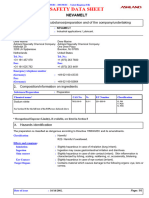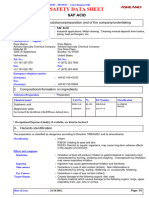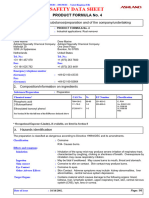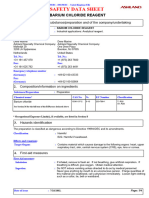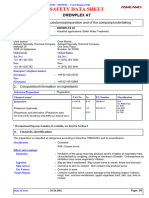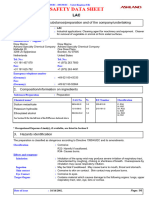Hhe4c5kub
Hhe4c5kub
Uploaded by
Nandar Min HtetCopyright:
Available Formats
Hhe4c5kub
Hhe4c5kub
Uploaded by
Nandar Min HtetOriginal Title
Copyright
Available Formats
Share this document
Did you find this document useful?
Is this content inappropriate?
Copyright:
Available Formats
Hhe4c5kub
Hhe4c5kub
Uploaded by
Nandar Min HtetCopyright:
Available Formats
Conforms to 91/155/EEC - 2001/58/EC - United Kingdom (UK)
SAFETY DATA SHEET
CWT-TITRET AMPOULE
1. Identification of the substance/preparation and of the company/undertaking
Product name : CWT-TITRET AMPOULE
Material Uses : Industrial applications: Analytical reagent.
Manufacturer / Supplier :
Drew Marine Drew Marine
Ashland Specialty Chemical Company Ashland Specialty Chemical Company
Malledijk 20 One Drew Plaza
3208 LA Spijkenisse Boonton, NJ 07005
Netherlands United States
Tel. No.: Tel. No.:
+31 181 457 070 +1 (973) 263 7600
Fax: Fax:
+31 181 625 792 +1 (973) 263 4491
Emergency telephone number
(Germany) : +49 621 60-43333
Fax:
(Germany) : +49 621 60-92664
2. Composition/information on ingredients
Substance/Preparation : Preparation
Chemical characterization : Contains : Sulphuric acid: 3%
Chemical name* CAS No. % EC Number Classification
Sulphuric acid 7664-93-9 1-5 231-639-5 C; R35
See Section 16 for the full text of the R Phrases declared above
* Occupational Exposure Limit(s), if available, are listed in Section 8
3. Hazards identification
The preparation is not classified as dangerous according to Directive 1999/45/EC and its amendments.
Classification :
This product is not classified according to the EU regulations.
Effects and symptoms
Inhalation : Slightly hazardous in case of inhalation.
Skin contact : Slightly hazardous in case of skin contact (irritant). Skin inflammation is
characterized by itching, scaling, reddening, or, occasionally, blistering.
Eye Contact : Slightly hazardous in case of eye contact (irritant).
Target Organs : Contains material which causes damage to the following organs: lungs,
mucous membranes, upper respiratory tract, skin, eye, lens or cornea, teeth.
Date of issue : 7/18/2002. Page: 1/5
CWT-TITRET AMPOULE
4. First-aid measures
First-Aid measures
Inhalation : If inhaled, remove to fresh air. If not breathing, give artificial respiration. If
breathing is difficult, give oxygen. Get medical attention if symptoms appear.
Ingestion : Do NOT induce vomiting unless directed to do so by medical personnel.
Never give anything by mouth to an unconscious person. Loosen tight clothing
such as a collar, tie, belt or waistband. Get medical attention if symptoms
appear.
Skin contact : Wash with soap and water. Cover the irritated skin with an emollient. Get
medical attention if irritation develops. Cold water may be used.
Eye Contact : Check for and remove any contact lenses. In case of contact, immediately
flush eyes with a copious amount of water for at least 15 minutes. Cold water
may be used. Get medical attention if irritation occurs.
5. Fire-fighting measures
Extinguishing Media
Suitable : Not applicable.
Hazardous thermal (de)composition : These products are sulphur oxides (SO2, SO3, etc.).
products
Protection of fire-fighters : Fire fighters should wear self-contained positive pressure breathing apparatus
(SCBA) and full turnout gear.
6. Accidental release measures
Personal Precautions : Splash goggles. Full suit. Vapour respirator. Boots. Gloves. A self-contained
breathing apparatus should be used to avoid inhalation of the product.
Suggested protective clothing might not be sufficient; consult a specialist
BEFORE handling this product.
Environmental precautions and : Absorb with an inert material and put the spilled material in an appropriate
cleanup methods waste disposal. Finish cleaning by spreading water on the contaminate
surface and allow to evacuate through the sanitary system.
Note: See section 8 for personal protective equipment and section 13 for waste disposal.
7. Handling and storage
Handling : Do not breathe gas/fumes/vapour/spray. If ingested, seek medical advice
immediately and show the container or the label. Use only in accordance
with Drew Test Procedures
Storage : Keep container tightly closed. Keep container in a cool, well-ventilated area.
Do not store below 5°C (41°F).
Packaging materials
Recommended use : Use original container.
8. Exposure controls/personal protection
Engineering measures : Provide exhaust ventilation or other engineering controls to keep the airborne
concentrations of vapours below their respective occupational exposure limits.
Hygiene measures : Wash hands after handling compounds and before eating, smoking, using
lavatory, and at the end of day.
Occupational Exposure Limits
Date of issue : 7/18/2002. Page: 2/5
CWT-TITRET AMPOULE
Ingredient Name Occupational Exposure Limits
Sulphuric acid EH40-OES (United Kingdom (UK), 2001). Notes: OES
TWA: 1 mg/m3 Form: Solution
Respiratory system : Wear appropriate respirator when ventilation is inadequate. Vapour respirator.
(as filter E)
Skin and body : Lab coat.
Hands : Impervious gloves.
Eyes : Safety glasses.
9. Physical and chemical properties
Physical state : Liquid. (Ampoule)
Colour : Clear. Colourless. / Brown.
Odour : Odourless.
Boiling point : 100°C (212°F)
Melting point : 3°C (37°F)
Density : 1.03 g/cm3 (20°C / 68°F)
Vapour pressure : 2.4 kPa (18 mmHg) (at 20°C)
Evaporation Rate : 0.36 (Water) compared to n-Butyl acetate
Solubility : Easily soluble in cold water.
pH : 1 [Acidic.]
Flash point : Not applicable.
10. Stability and reactivity
Stability : The product is stable.
Materials to avoid : Slightly reactive to reactive with metals, alkalis.
Incompatible with some alkalis. Incompatible with finely-powdered metals.
Hazardous decomposition products : These products are sulphur oxides (SO2, SO3, etc.).
Remarks : Flammable hydrogen gas may be produced on prolonged contact with metals
such as aluminium, tin, lead and zinc.
11. Toxicological information
Acute toxicity
Ingredient Name Test Result Route Species
Sulphuric acid LD50 2140 mg/kg Oral Rat
LC50 510 mg/m3 Inhalation Rat
(2 hours)
Chronic toxicity : Repeated exposure to an highly toxic material may produce general
deterioration of health by an accumulation in one or many human organs.
Local effects
Skin irritation : Slightly hazardous in case of skin contact (irritant).
Eye irritation : Slightly hazardous in case of eye contact (irritant).
Specific effects
Carcinogenic effects : Classified A2 (Suspected for humans.) by ACGIH [Sulphuric acid].
Date of issue : 7/18/2002. Page: 3/5
CWT-TITRET AMPOULE
Mutagenic Effects : Not available.
Reproduction toxicity : Not available.
12. Ecological information
Persistence/degradability : Not available.
13. Disposal considerations
Methods of disposal ; Waste of : Waste must be disposed of in accordance with federal, state and local
residues ; Contaminated packaging environmental control regulations.
European Waste Catalogue (EWC) : 16 05 02
Hazardous Waste : The classification of the product may meet the criteria for a hazardous waste.
Additional Information : 16 05 02 other waste containing inorganic chemicals, e.g. lab chemicals not
otherwise specified, fire extinguishing powders
14. Transport information
International transport regulations
Land - Road/Railway
UN number : Not regulated.
Proper shipping name : -
ADR/RID Class : -
Other information : Remarks
Not controlled under ADR (Europe).
Sea
UN number : Not regulated.
Proper shipping name : -
IMDG Class : -
Other information : Remarks
Not controlled under IMDG.
15. Regulatory information
EU Regulations
Risk Phrases : This product is not classified according to the EU regulations.
Product Use : Classification and labelling have been performed according to EU directives
67/548/EEC, 88/379/EEC, including amendments and the intended use.
- Industrial applications.
16. Other information
Full text of R-Phrases with no. : R35- Causes severe burns.
appearing in Section 2 - United
Kingdom (UK)
Text of classifications appearing in : C - Corrosive
Section 2 - United Kingdom (UK)
HISTORY
Date of printing : 10/21/2002.
Date of issue : 7/18/2002.
Version : 2.07
Date of issue : 7/18/2002. Page: 4/5
CWT-TITRET AMPOULE
CWT-TITRET® AMPOULES is a registered trademark of Ashland Inc.
Notice to Reader
To the best of our knowledge, the information contained herein is accurate. However, neither the above named supplier nor
any of its subsidiaries assumes any liability whatsoever for the accuracy or completeness of the information contained
herein.
Final determination of suitability of any material is the sole responsibility of the user. All materials may present unknown
hazards and should be used with caution. Although certain hazards are described herein, we cannot guarantee that these
are the only hazards that exist.
Date of issue Version
7/18/2002. 2.07 Page: 5/5
Conforms to 91/155/EEC - 2001/58/EC - United Kingdom (UK)
SAFETY DATA SHEET
CWT-TITRET Valve Assembly
1. Identification of the substance/preparation and of the company/undertaking
Product name : CWT-TITRET Valve Assembly
Chemical product name : Diethylene glycol
Chemical formula : C4-H10-O3
Material Uses : Industrial applications: Analytical reagent.
Manufacturer / Supplier :
Drew Marine Drew Marine
Ashland Specialty Chemical Company Ashland Specialty Chemical Company
Malledijk 20 One Drew Plaza
3208 LA Spijkenisse Boonton, NJ 07005
Netherlands United States
Tel. No.: Tel. No.:
+31 181 457 070 +1 (973) 263 7600
Fax: Fax:
+31 181 625 792 +1 (973) 263 4491
Emergency telephone number
(Germany) : +49 621 60-43333
Fax:
(Germany) : +49 621 60-92664
2. Composition/information on ingredients
Substance/Preparation : Substance
Chemical name* CAS No. % EC Number Classification
Diethylene glycol 111-46-6 90-100 203-872-2 Xn; R22
See Section 16 for the full text of the R Phrases declared above
* Occupational Exposure Limit(s), if available, are listed in Section 8
3. Hazards identification
The substance is classified as dangerous according to Directive 2001/59/EC.
Classification : Harmful
R22- Harmful if swallowed.
Effects and symptoms
Target Organs : Causes damage to the following organs: kidneys, liver, skin, eyes, eye, lens or
cornea.
4. First-aid measures
First-Aid measures
Inhalation : If inhaled, remove to fresh air. If not breathing, give artificial respiration. If
breathing is difficult, give oxygen. Obtain medical attention.
Ingestion : Do NOT induce vomiting unless directed to do so by medical personnel.
Never give anything by mouth to an unconscious person. If large quantities of
this material are swallowed, call a physician immediately. Loosen tight clothing
such as a collar, tie, belt or waistband.
Date of issue : 10/16/2002. Page: 1/5
CWT-TITRET Valve Assembly
Skin contact : Wash with soap and water. Get medical attention if irritation develops. Cold
water may be used
Eye Contact : Check for and remove any contact lenses. In case of contact, immediately
flush eyes with a copious amount of water for at least 15 minutes. Cold water
may be used. Obtain medical attention.
5. Fire-fighting measures
Extinguishing Media
Suitable : SMALL FIRE: Use dry chemical powder or CO2.
LARGE FIRE: Use water spray, fog or foam. Do not use water jet.
Hazardous thermal (de)composition : These products are carbon oxides (CO, CO2) and water.
products
Protection of fire-fighters : Fire fighters should wear self-contained positive pressure breathing apparatus
(SCBA) and full turnout gear.
6. Accidental release measures
Personal Precautions : Splash goggles. Full suit. Boots. Gloves. Suggested protective clothing
might not be sufficient; consult a specialist BEFORE handling this product.
Environmental precautions and : Absorb with an inert material and put the spilled material in an appropriate
cleanup methods waste disposal. Finish cleaning by spreading water on the contaminate
surface and allow to evacuate through the sanitary system.
Note: See section 8 for personal protective equipment and section 13 for waste disposal.
7. Handling and storage
Handling : Keep away from heat. Keep away from sources of ignition. Empty containers
pose a fire risk, evaporate the residue under a fume hood. Do not breathe
gas/fumes/vapour/spray. If ingested, seek medical advice immediately and
show the container or the label. Keep away from incompatibles such as
oxidizing agents. Use only in accordance with Drew Test Procedures.
Storage : Keep container tightly closed. Keep container in a cool, well-ventilated area.
Packaging materials
Recommended use : Use original container.
8. Exposure controls/personal protection
Engineering measures : Provide exhaust ventilation or other engineering controls to keep the airborne
concentrations of vapours below their respective occupational exposure limits.
Ensure that eyewash stations and safety showers are close to the workstation
location.
Hygiene measures : Wash hands, forearms, and face thoroughly after handling compounds and
before eating, smoking, using lavatory, and at the end of day.
Occupational Exposure Limits
Ingredient Name Occupational Exposure Limits
Diethylene glycol EH40-OES (United Kingdom (UK), 2001). Notes: OES
TWA: 101 mg/m3
TWA: 23 ppm
Skin and body : Lab coat.
Hands : Impervious gloves.
Eyes : Safety glasses.
Date of issue : 10/16/2002. Page: 2/5
CWT-TITRET Valve Assembly
9. Physical and chemical properties
Physical state : Liquid.
Colour : Colourless.
Odour : Odourless.
Boiling point : 245°C (473°F)
Melting point : -6°C (21°F)
Density : 1.118 g/cm3
Vapour density : 3.7 (Air = 1)
Vapour pressure : 0.00067 kPa (0.005 mmHg) (at 20°C)
Evaporation Rate : <0.01 compared to Butyl acetate.
Solubility : Easily soluble in cold water.
Octanol/water partition coefficient : The product is more soluble in water; log(octanol/water)-2
pH : Not available.
Flash point : OPEN CUP: 124°C (255.2°F).
Autoignition temperature : >220°C (428°F)
Lower explosion limit : LOWER: 1.8% UPPER: 12.2%
10. Stability and reactivity
Stability : The product is stable.
Materials to avoid : Reactive with oxidizing agents.
Hazardous decomposition products : These products are carbon oxides (CO, CO2) and water.
11. Toxicological information
Acute toxicity
Ingredient Name Test Result Route Species
Diethylene glycol LD50 12565 Oral Rat
mg/kg
LD50 4400 mg/kg Oral Rabbit
LD50 3300 mg/kg Oral Cat
LD50 11890 Dermal Rabbit
mg/kg
Chronic toxicity : Repeated or prolonged exposure is not known to aggravate medical condition.
Carcinogenic effects : Not available.
Mutagenic Effects : Not available.
Reproduction toxicity : Not available.
12. Ecological information
Persistence/degradability : Not available.
Bioaccumulative potential : This product shows a low bioaccumulation potential.
Date of issue : 10/16/2002. Page: 3/5
CWT-TITRET Valve Assembly
13. Disposal considerations
Methods of disposal ; Waste of : Waste must be disposed of in accordance with federal, state and local
residues ; Contaminated packaging environmental control regulations.
European Waste Catalogue (EWC) : 16 05 03
Hazardous Waste : The classification of the product may meet the criteria for a hazardous waste.
Additional Information : 16 05 03 other waste containing organic chemicals, e.g. lab chemicals not
otherwise specified
14. Transport information
International transport regulations
Land - Road/Railway
UN number : Not regulated.
Proper shipping name : -
ADR/RID Class : -
Other information : Remarks
Not controlled under ADR (Europe).
Sea
UN number : Not regulated.
Proper shipping name : -
IMDG Class : -
Other information : Remarks
Not controlled under IMDG.
15. Regulatory information
EU Regulations
Hazard symbol(s) :
Harmful
Risk Phrases : R22- Harmful if swallowed.
Safety Phrases : S46- If swallowed, seek medical advice immediately and show this container
or label.
Contains : Diethylene glycol 203-872-2
Product Use : Classification and labelling have been performed according to EU directives
67/548/EEC, 88/379/EEC, including amendments and the intended use.
- Industrial applications.
16. Other information
Full text of R-Phrases with no. : R22- Harmful if swallowed.
appearing in Section 2 - United
Kingdom (UK)
Text of classifications appearing in : Xn - Harmful
Section 2 - United Kingdom (UK)
HISTORY
Date of printing : 10/21/2002.
Date of issue : 10/16/2002.
Version : 3
CWT-TITRET® Valve Assemly
Date of issue : 10/16/2002. Page: 4/5
CWT-TITRET Valve Assembly
Notice to Reader
To the best of our knowledge, the information contained herein is accurate. However, neither the above named supplier nor
any of its subsidiaries assumes any liability whatsoever for the accuracy or completeness of the information contained
herein.
Final determination of suitability of any material is the sole responsibility of the user. All materials may present unknown
hazards and should be used with caution. Although certain hazards are described herein, we cannot guarantee that these
are the only hazards that exist.
Date of issue Version
10/16/2002. 3 Page: 5/5
You might also like
- Fire and Safety in Edible Oil Industries To Be AdoptedDocument68 pagesFire and Safety in Edible Oil Industries To Be AdoptedRushiram Reddy60% (5)
- 0041 Q6boc5kubDocument5 pages0041 Q6boc5kubNandar Min HtetNo ratings yet
- 0045 Lfu5c5kubDocument5 pages0045 Lfu5c5kubNandar Min HtetNo ratings yet
- 1280 Bktpc5kubDocument5 pages1280 Bktpc5kubNandar Min HtetNo ratings yet
- 0089 Ei6uc5kubDocument5 pages0089 Ei6uc5kubNandar Min HtetNo ratings yet
- 1725 Hnu5c5kubDocument5 pages1725 Hnu5c5kubNandar Min HtetNo ratings yet
- 5247 Qahtc5kubDocument5 pages5247 Qahtc5kubNandar Min HtetNo ratings yet
- 1277 Upu8c5kubDocument4 pages1277 Upu8c5kubNandar Min HtetNo ratings yet
- 0544 E1ifc5kubDocument5 pages0544 E1ifc5kubNandar Min HtetNo ratings yet
- 9534 G499c5kubDocument5 pages9534 G499c5kubNandar Min HtetNo ratings yet
- 1732 0btnc5kubDocument4 pages1732 0btnc5kubNandar Min HtetNo ratings yet
- 1706 Hdtpc5kubDocument5 pages1706 Hdtpc5kubNandar Min HtetNo ratings yet
- AGK-100 Phosphate AmpoulesDocument5 pagesAGK-100 Phosphate AmpoulesSENTHIL KUMARNo ratings yet
- 4907 Avkbc5kubDocument5 pages4907 Avkbc5kubNandar Min HtetNo ratings yet
- 0062 J5tfc5kubDocument5 pages0062 J5tfc5kubNandar Min HtetNo ratings yet
- 0830 Bpvac5kubDocument5 pages0830 Bpvac5kubNandar Min HtetNo ratings yet
- 5482 3a11c5kubDocument4 pages5482 3a11c5kubNandar Min HtetNo ratings yet
- 9511 Lktjc5kubDocument5 pages9511 Lktjc5kubNandar Min HtetNo ratings yet
- 9517 K87fc5kubDocument5 pages9517 K87fc5kubNandar Min HtetNo ratings yet
- 1273 20bgc5kubDocument5 pages1273 20bgc5kubNandar Min HtetNo ratings yet
- 1743 Tdjsc5kubDocument5 pages1743 Tdjsc5kubNandar Min HtetNo ratings yet
- 1213 28v5c5kubDocument5 pages1213 28v5c5kubNandar Min HtetNo ratings yet
- 1702 Tq0ac5kubDocument4 pages1702 Tq0ac5kubNandar Min HtetNo ratings yet
- 0571 3fvkc5kubDocument5 pages0571 3fvkc5kubNandar Min HtetNo ratings yet
- 0011 1550c5kubDocument5 pages0011 1550c5kubNandar Min HtetNo ratings yet
- 7266 Fq1hc5kubDocument5 pages7266 Fq1hc5kubNandar Min HtetNo ratings yet
- 618bc5kubDocument4 pages618bc5kubNandar Min HtetNo ratings yet
- 1272 0s3cc5kubDocument5 pages1272 0s3cc5kubNandar Min HtetNo ratings yet
- 1270 Lh7vc5kubDocument6 pages1270 Lh7vc5kubNandar Min HtetNo ratings yet
- 0651 Lb6gc5kubDocument5 pages0651 Lb6gc5kubNandar Min HtetNo ratings yet
- 2bhlc5kubDocument4 pages2bhlc5kubNandar Min HtetNo ratings yet
- 1214 Lfp0c5kubDocument4 pages1214 Lfp0c5kubNandar Min HtetNo ratings yet
- 4608 Vpmmc5kubDocument5 pages4608 Vpmmc5kubNandar Min HtetNo ratings yet
- 1265 Tvtnc5kubDocument5 pages1265 Tvtnc5kubNandar Min HtetNo ratings yet
- 0808 65m7c5kubDocument5 pages0808 65m7c5kubNandar Min HtetNo ratings yet
- 1726 Q99kc5kubDocument5 pages1726 Q99kc5kubNandar Min HtetNo ratings yet
- D0tqc5kubDocument5 pagesD0tqc5kubNandar Min HtetNo ratings yet
- Gfebc5kubDocument4 pagesGfebc5kubNandar Min HtetNo ratings yet
- 5483 Ahi7c5kubDocument5 pages5483 Ahi7c5kubNandar Min HtetNo ratings yet
- 0082 Hvipc5kubDocument5 pages0082 Hvipc5kubNandar Min HtetNo ratings yet
- Dn63c5kubDocument4 pagesDn63c5kubNandar Min HtetNo ratings yet
- 0065 Behqc5kubDocument4 pages0065 Behqc5kubNandar Min HtetNo ratings yet
- 0007 Ok15c5kubDocument5 pages0007 Ok15c5kubNandar Min HtetNo ratings yet
- 1274 N48uc5kubDocument6 pages1274 N48uc5kubNandar Min HtetNo ratings yet
- 0026 Bgvac5kubDocument5 pages0026 Bgvac5kubNandar Min HtetNo ratings yet
- 0076 Fi41c5kubDocument5 pages0076 Fi41c5kubNandar Min HtetNo ratings yet
- 1717 43eoc5kubDocument6 pages1717 43eoc5kubNandar Min HtetNo ratings yet
- 0098 T8f8c5kubDocument5 pages0098 T8f8c5kubNandar Min HtetNo ratings yet
- 1731 78mtc5kubDocument5 pages1731 78mtc5kubNandar Min HtetNo ratings yet
- 99p9c5kubDocument5 pages99p9c5kubNandar Min HtetNo ratings yet
- 0829 0ngvc5kubDocument5 pages0829 0ngvc5kubNandar Min HtetNo ratings yet
- P3-Topax 36Document5 pagesP3-Topax 36imranshaik3000No ratings yet
- 1259 P8e7c5kubDocument5 pages1259 P8e7c5kubNandar Min HtetNo ratings yet
- 0031 Ck14c5kubDocument5 pages0031 Ck14c5kubNandar Min HtetNo ratings yet
- 0091 Lpfvc5kubDocument5 pages0091 Lpfvc5kubNandar Min HtetNo ratings yet
- Savol Beerline CleanerDocument5 pagesSavol Beerline CleanerProsenjit76No ratings yet
- 6598 Gvecc5kubDocument6 pages6598 Gvecc5kubNandar Min HtetNo ratings yet
- 5315 55mgc5kubDocument4 pages5315 55mgc5kubNandar Min HtetNo ratings yet
- Hfutc5kubDocument4 pagesHfutc5kubNandar Min HtetNo ratings yet
- 4757 54a6c5kubDocument6 pages4757 54a6c5kubNandar Min HtetNo ratings yet
- 6598 Gvecc5kubDocument6 pages6598 Gvecc5kubNandar Min HtetNo ratings yet
- 7266 Fq1hc5kubDocument5 pages7266 Fq1hc5kubNandar Min HtetNo ratings yet
- 2bhlc5kubDocument4 pages2bhlc5kubNandar Min HtetNo ratings yet
- 5482 3a11c5kubDocument4 pages5482 3a11c5kubNandar Min HtetNo ratings yet
- 4139 Jo0mc5kubDocument6 pages4139 Jo0mc5kubNandar Min HtetNo ratings yet
- 5481 D9u7c5kubDocument5 pages5481 D9u7c5kubNandar Min HtetNo ratings yet
- 403 Between and Among 260322Document24 pages403 Between and Among 260322Nandar Min HtetNo ratings yet
- 0051 Strcc5kubDocument6 pages0051 Strcc5kubNandar Min HtetNo ratings yet
- 0651 Lb6gc5kubDocument5 pages0651 Lb6gc5kubNandar Min HtetNo ratings yet
- 1743 Tdjsc5kubDocument5 pages1743 Tdjsc5kubNandar Min HtetNo ratings yet
- 9517 K87fc5kubDocument5 pages9517 K87fc5kubNandar Min HtetNo ratings yet
- 1274 N48uc5kubDocument6 pages1274 N48uc5kubNandar Min HtetNo ratings yet
- 0031 Ck14c5kubDocument5 pages0031 Ck14c5kubNandar Min HtetNo ratings yet
- 0007 Ok15c5kubDocument5 pages0007 Ok15c5kubNandar Min HtetNo ratings yet
- 0091 Lpfvc5kubDocument5 pages0091 Lpfvc5kubNandar Min HtetNo ratings yet
- 0572 Ku0cc5kubDocument5 pages0572 Ku0cc5kubNandar Min HtetNo ratings yet
- 0036 6t5ec5kubDocument7 pages0036 6t5ec5kubNandar Min HtetNo ratings yet
- Participle Clauses-260322Document34 pagesParticiple Clauses-260322Nandar Min HtetNo ratings yet
- 0057 M4t2c5kubDocument6 pages0057 M4t2c5kubNandar Min HtetNo ratings yet
- Adjectives Without Nouns-260322Document27 pagesAdjectives Without Nouns-260322Nandar Min HtetNo ratings yet
- 21.1 Topic SUCCESS Lesson Notes-6Document1 page21.1 Topic SUCCESS Lesson Notes-6Nandar Min HtetNo ratings yet
- Experiment and Experience-260322Document30 pagesExperiment and Experience-260322Nandar Min HtetNo ratings yet
- Kenshin Myanmar 3 Cross-Shaped ScarDocument140 pagesKenshin Myanmar 3 Cross-Shaped ScarNandar Min HtetNo ratings yet
- Kenshin Myanmar 2 Legend of KyotoDocument137 pagesKenshin Myanmar 2 Legend of KyotoNandar Min HtetNo ratings yet
- Kenshin Myanmar 1 Wandering SamuraiDocument170 pagesKenshin Myanmar 1 Wandering SamuraiNandar Min HtetNo ratings yet
- Wildplus Body Juice 2Document10 pagesWildplus Body Juice 2tu26061999No ratings yet
- SP Report 2007 08Document64 pagesSP Report 2007 08Gianni MenaNo ratings yet
- Safety Data Sheet: Section 1: IdentificationDocument6 pagesSafety Data Sheet: Section 1: IdentificationkhairunisaNo ratings yet
- Design of Sprinklered Shopping Centre Buildings For Fire SafetyDocument42 pagesDesign of Sprinklered Shopping Centre Buildings For Fire SafetyZyron BatacNo ratings yet
- The Day I Went To The Fire Station StoryDocument2 pagesThe Day I Went To The Fire Station Storyanjuli51710No ratings yet
- MSDS (16) Foamaxx QS PlusDocument4 pagesMSDS (16) Foamaxx QS PlusKhadar SetiawanNo ratings yet
- What Is A Firefighter?Document3 pagesWhat Is A Firefighter?Paula MhaelaNo ratings yet
- 2021-02-18 St. Mary's County TimesDocument32 pages2021-02-18 St. Mary's County TimesSouthern Maryland OnlineNo ratings yet
- Isopar HDocument10 pagesIsopar HFernando HarahapNo ratings yet
- Hand Sanitizer, Instant, Novaclenz - MSDSDocument15 pagesHand Sanitizer, Instant, Novaclenz - MSDSWhitley RichardsNo ratings yet
- Sds Gwax Eur EnglishDocument11 pagesSds Gwax Eur Englishperret.yap.weilunNo ratings yet
- Recommended Reading ListDocument9 pagesRecommended Reading Listkashifbutty2kNo ratings yet
- V4040a-Mogas Naphtha Catalytic Reformed-Naphtha Petroleum Catalytic Reformed Esds en v4.1Document26 pagesV4040a-Mogas Naphtha Catalytic Reformed-Naphtha Petroleum Catalytic Reformed Esds en v4.1Emre ÖzbilgiNo ratings yet
- Aral Fliessfett N Germany English-Gb SDB 456277Document11 pagesAral Fliessfett N Germany English-Gb SDB 456277Техник СвязиNo ratings yet
- Fire Fighting CodesDocument9 pagesFire Fighting CodesSandeep VarmaNo ratings yet
- Material Safety Data Sheet: I. Product and Factory InformationDocument6 pagesMaterial Safety Data Sheet: I. Product and Factory InformationFazrryMirzaNo ratings yet
- 01 13 16Document26 pages01 13 16WoodsNo ratings yet
- Nisp Course CatalogDocument32 pagesNisp Course CatalogMikahil Mutiu Mutespa100% (1)
- Resume WeeblyDocument3 pagesResume Weeblyapi-484790916No ratings yet
- Wax-stick , Cp2635, Synthetic Beeswax (Bolflex 8980 Msds - EnDocument8 pagesWax-stick , Cp2635, Synthetic Beeswax (Bolflex 8980 Msds - EnfivevirNo ratings yet
- List of Fees and Charges ChangiDocument8 pagesList of Fees and Charges ChangiDzety NasaNo ratings yet
- Fire Safety at WorkDocument8 pagesFire Safety at Workapi-26802090100% (1)
- Elphos Erald: Volunteer Firefighters Make Double SacrificeDocument12 pagesElphos Erald: Volunteer Firefighters Make Double SacrificeThe Delphos HeraldNo ratings yet
- Murray Fire 9-7-22 UPDATEDocument1 pageMurray Fire 9-7-22 UPDATENBC MontanaNo ratings yet
- BoschBattery SDSDocument8 pagesBoschBattery SDSJunk LIamNo ratings yet
- Module 1-C Emergency PreparednessDocument9 pagesModule 1-C Emergency PreparednessRobin RubinaNo ratings yet
- LGR 03. Enersyn RX-100Document5 pagesLGR 03. Enersyn RX-100S Eshgin AlizadeNo ratings yet
- Firefighters' Smoke Control Station: FeaturesDocument3 pagesFirefighters' Smoke Control Station: FeaturesirfanNo ratings yet
- Fire Safety - in Case of Fire (EN and SP)Document3 pagesFire Safety - in Case of Fire (EN and SP)pruncu.alianmNo ratings yet









